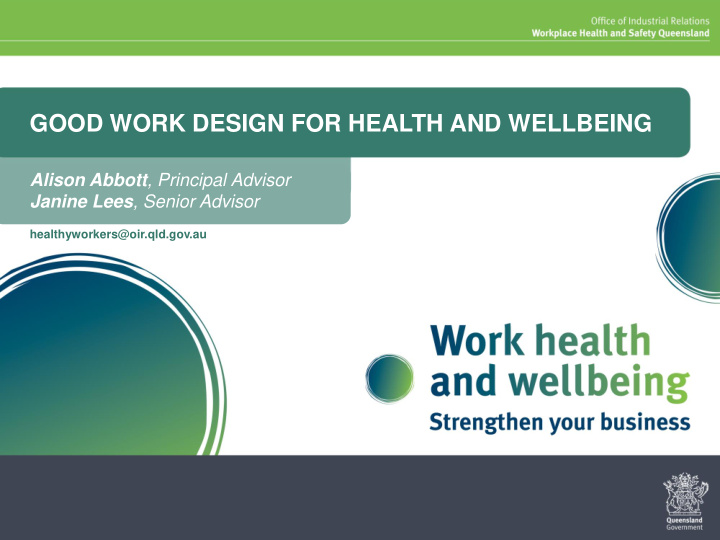



GOOD WORK DESIGN FOR HEALTH AND WELLBEING Alison Abbott , Principal Advisor Janine Lees , Senior Advisor healthyworkers@oir.qld.gov.au
Six megatrends important to workplaces 1. The extended reach of automated systems and robotics 2. Rising issue of workplace stress and mental health issues 3. Increasing screen time, sedentary behaviour and chronic illness 4. Blurring the boundaries between work and home 5. The gig and entrepreneurial economy 6. An ageing workforce Source: Workplace Safety Futures, Safe Work Australia, Data 61, CSIRO, 2018 Slide attributed to Professor Niki Ellis, 2019
There is a relationship between health and injury Additional health conditions Increased Asthma risk of injury Chronic obstructive pulmonary disease Prolonged hospitalisation and rehab Ischaemic heart disease Heart failure Diabetes mellitus Illnesses are Higher associated treatment Mental health condition costs with… (Depression, bipolar, anxiety; schizophrenia) Cancer diagnosis Higher risk of becoming permanently (Lung, breast, colon, cervix, Increased unable to prostate) time off due work to treatment and rehab Osteoarthritis complications Source: Gribben & Wren, 2012
Chronic disease risks for workplaces 96% report at least one risk factor 1st Smoking 2nd 75% report multiple risk factors Poor diet 3rd Overweight of people drink at risky levels 70% and obesity which equates to about 550,000 Leading risk factors for disease are overweight or obese or 60% about 540,000 people Source: www.health.qld.gov.au/CHO_report of smokers work which equates 58% to about 250,000 workers 1 in 3 Australians with a mental 31% health condition reported taking time away from work or study
Benefits to business Injury risk is Workers who have never smoked have a lower lower for healthy weight workers risk workers compared to obese or of work-related injury than those who have smoked. overweight workers US study – Obesity was associated with increased costs among workers’ compensation claimants sustaining severe injuries. Healthy workers have less sick days Likelihood of return to work: than unhealthy workers 20 days – 70% of returning 45 days – 50% of returning 70 days – 35% of returning AFOEM and RACP Realising the health benefits of work (2011)
Work health and wellbeing ? ? ? What factors contribute to ? ? work health and wellbeing? ? ? ?
Work Related Risk Factors Increased risk of (individual factors) related to poor health outcomes • Heart disease High levels of stress • Diabetes Lack of job control • Some cancers Time pressures • Ill health Hazardous working conditions Long working hours Physically demanding tasks Lack of work-life balance Increased risk of (work factors) Raised level of fatigue • Risk of injury Sedentary/lack of movement • Accidents • Absenteeism Limited access to healthy food • Turnover of staff • Reduced productivity
Good Work Design How work is performed, including the physical and mental demands of the tasks; The task duration, frequency and complexity; Organisation The context and systems of work. of work Plant, equipment, materials and substances used; The vehicles, buildings, structures that are workplaces. Work environment Physical and mental capabilities and needs. Worker
Key resources https://www.worksafe.qld.gov.au/ health-wellbeing/home
Work Health and Wellbeing Toolkit Plan • Management commitment • Worker participation • Setting up evaluation • Assessing risks
Healthy workplaces survey This survey highlights what you have in place and where you can improve and build on. WORKPLACE SURVEY Elements • Organisation • Policy and procedures • Communication and consultation • Physical environment • Worker directed interventions.
Healthy workers survey
Work Health and Wellbeing Toolkit Implement Develop an action plan: • Work organisation • Work environment • Workers
Action Plan and Intervention Tools These Tools assist organisations to prioritise interventions to influence the way work is organised and the work environment which will have the biggest impact towards creating a healthy workplace. • ACTION PLAN • WORK HEALTH AND WELLBEING INTERVENTIONS TOOL • REVIEW INTERVENTION TOOL
Work Health and Wellbeing Toolkit Evaluate • Measuring and monitoring success
Evaluation tools It is important to report back and update management on workers progress. Transparency and celebrating success can assist with excitement and enthusiasm. • KEY MOTIVATOR TOOL (from planning stage) • EVALUATION FACTSHEET • REVIEW INTERVENTION TOOL (from implementation phase)
Within a few months… Within 1- 2 years… Employee engagement Health knowledge Within 3- 5 years +… Team cohesiveness Health behaviour Return on Participation change investing in a Job satisfaction health and Workforce wellbeing program commitment Work culture Productivity Absenteeism Org. practice and Injury rates policy Workers Company compensation image/reputation costs Risk mitigation Staff retention
Total Worker Health Eliminate working conditions or environments that are hazardous to work health, safety & wellbeing Involve workers to identify problems & assist with solutions https://www.cdc.gov/niosh/twh/default.html
Work health and wellbeing workshops Free workshops across Queensland Two streams Part 1 – planning Part 2 – implementing and evaluating Book online https://www.worksafe.qld.gov.au/injury-prevention-safety/health-and- wellbeing-at-work/events
Be Recognised Three levels Apply online Gold Silver Bronze Current Gold recognised workplaces – Burnside State School – Cancer Council Queensland – Dept. Transport and Main Roads – IT department – Ipswich State High School – Queensland University of Technology
BeUpstanding Champion Toolkit Addressing the growing hazard of occupational sitting https://beupstanding.com.au/
Be part of the NHMRC BeUpstanding research project Being launched by end June 2019 Commit to 1 hour per week for at least 3 months Commit to promoting and providing pre and post surveys Commit to a brief follow-up interview/survey in 9 months to assess maintenance What you get in return One on one coaching (telephone, workshops) Snazzy evaluation report Contact Dr Ana Goode a.goode@sph.uq.edu.au
Assists Qlders to reduce their risk of developing chronic conditions such as type 2 diabetes, heart disease and stroke. FREE 10 minute health checks for workers FREE 6 month behaviour change program for those at high risk of developing a chronic disease De-identified report showing: • Numbers at high, medium and low risk of developing a chronic disease • Numbers referred to the lifestyle coaching program
Questions? Questions
Contact us For more information visit https://www.worksafe.qld.gov.au/healthy-workers Or email to healthyworkers@oir.qld.gov.au
Recommend
More recommend